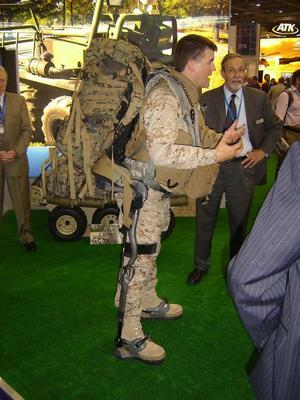In the trenchesExoskeleton to be equipped with a 3-day fuel cell powerpack
The Human Universal Load Carrier (HULC) powered suit runs on lithium-ion batteries at present; it allows a soldier to march easily with a load of 200 lb, but it normally runs flat after just a few hours — significantly less if any jogging or running is done; a new powerpack will correct that

HULC // Source: theregister.co.uk
A radical powered exoskeleton under development for use by the U.S. military is to be fitted with fuel-cell power supplies which will increase its endurance from hours to days — and furnish power for the burgeoning load of electronics carried by modern soldiers, too.
Lockheed, developing the Human Universal Load Carrier (HULC) after buying the originating firm Berkely Bionics, announced last week that fuel-cell firm Protonex will “develop power supply concepts that will enable the HULC robotic exoskeleton to support 72+-hour extended missions”.
Lewis Page writes that Protonex has previously worked on military fuel cells for the U.S. Army, using proton-exchange-membrane cells running on reformed methanol fuel. With today’s soldiers carrying increasing amounts of portable electronics — night-vision devices, weapon sights, communication gear – there is a need for options other than carrying mountains of spare batteries or lugging engine-driven generators about.
The HULC powered suit runs on li-ion batteries at present. Though it allows a soldier to march easily with a load of 200 lb, it normally runs flat after just a few hours — significantly less if any jogging or running is done.
Lockheed, however, believes that a fuel cell powered version could go for days on one fill of juice. Even better, it would offer power sockets for all the wearer’s other electronics, meaning that spare — or even, perhaps, primary — batteries could be left behind.
Lockheed’s Rich Russell describes this as a “whole system” approach. “With proper power management systems, the HULC can be used to recharge critical equipment while carrying heavy combat loads on an extended mission,” he says.
Stripping the batteries from a soldier or special operations trooper’s load would free up the entire mighty carrying capacity of the HULC for more attractive options such as armor, weapons etc. Page has previously pointed outthat remote-controlled powered gun mounts as light as 55 lb can be had, able to handle various heavy weapons normally requiring a tripod or bipod for dismounted infantry use. These would be ideal for installation above a HULC-wearer’s shoulder, and easily set up so as to train the big gun to follow a head-mounted monocle pointing rig of some sort.
Other accessories already offered include an armor-plated “ballistic shield” to be mounted in front of a wearer’s body, or “heating or cooling systems, sensors and other custom attachments.”
Page interviewed HULC inventor Russdon Angold in his suit last year. His demonstration confirmed Lockheed’s claims that the suit is quite mobile and capable of running, squatting, kneeling, etc. without difficulty. It offers no assistance to the wearer’s arms, but over-the-shoulder frames can be used along with a lifting strop to hoist heavy objects off the ground or support kit in front of the user.
Lockheed representatives said the suit was still “in ruggedization” at that point, however. They envisaged trials to gain input from actual U.S. troops beginning this summer.
